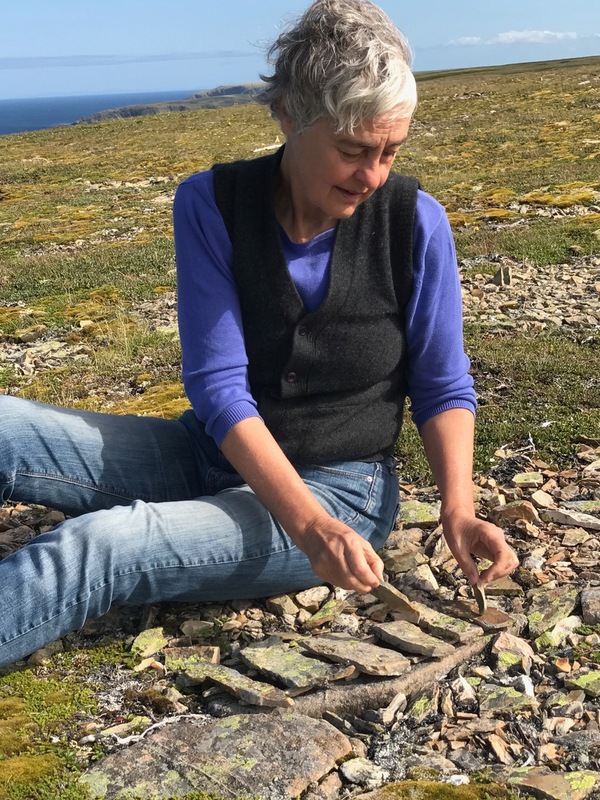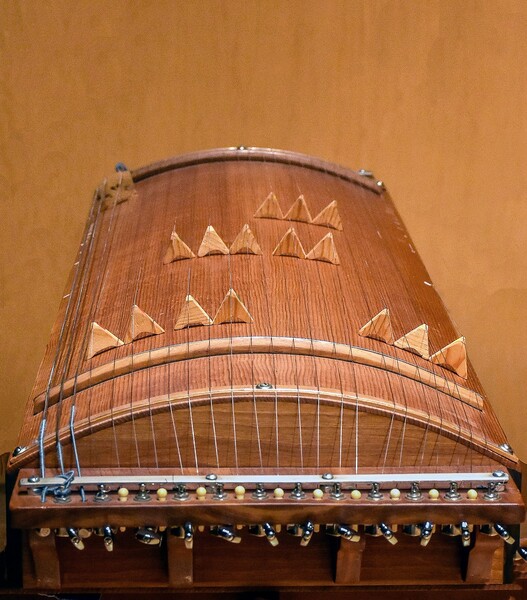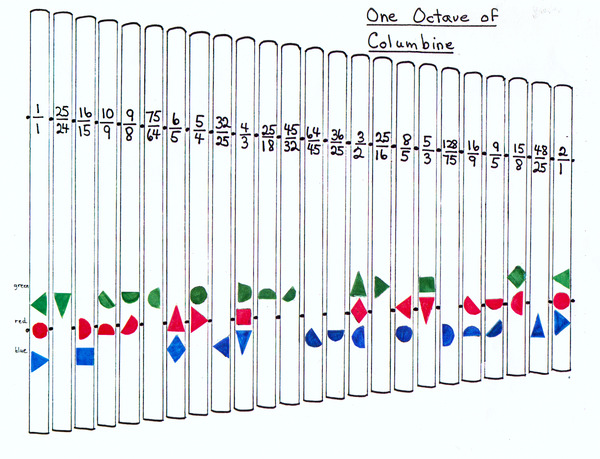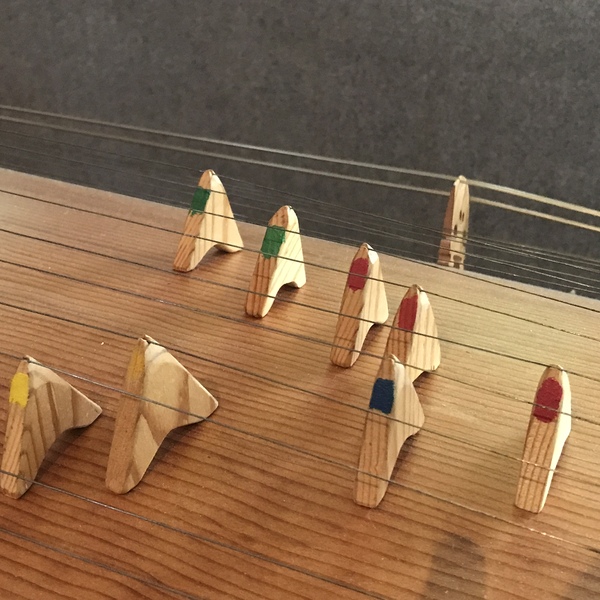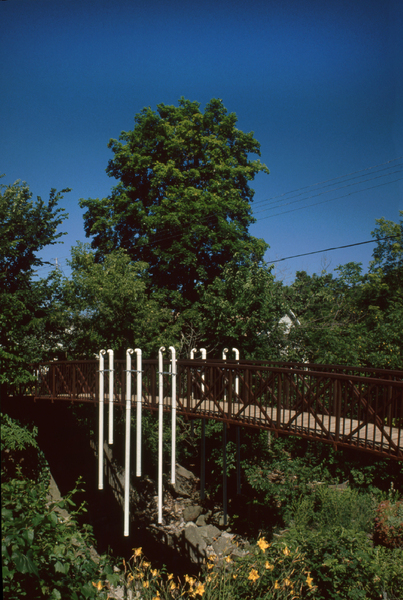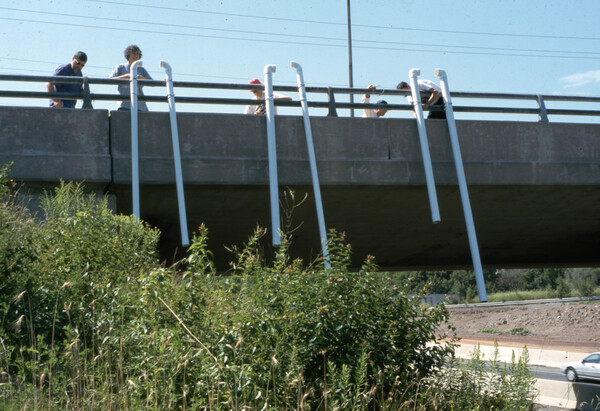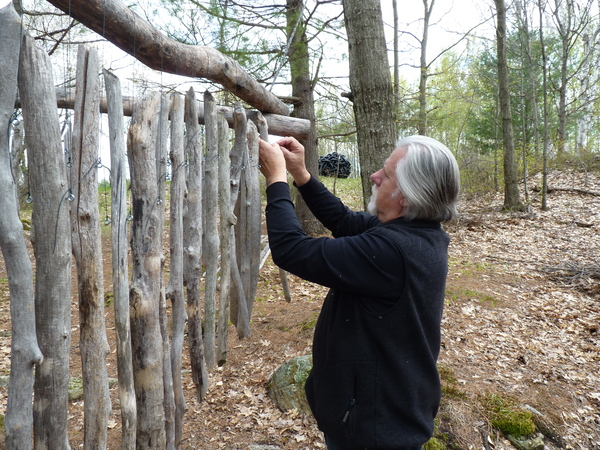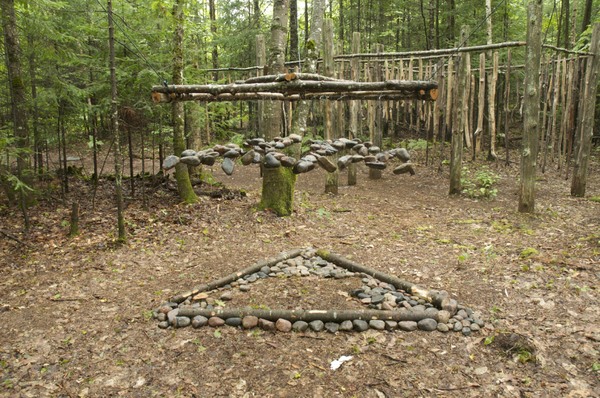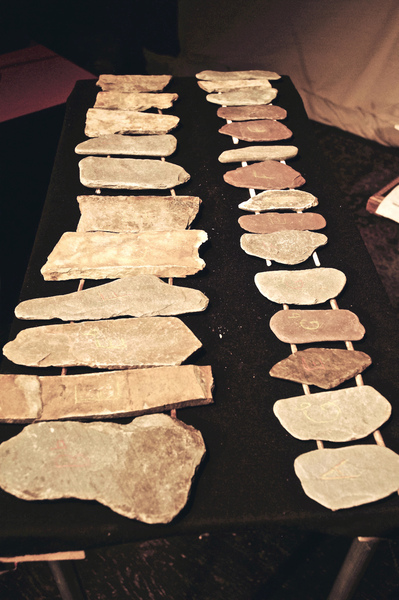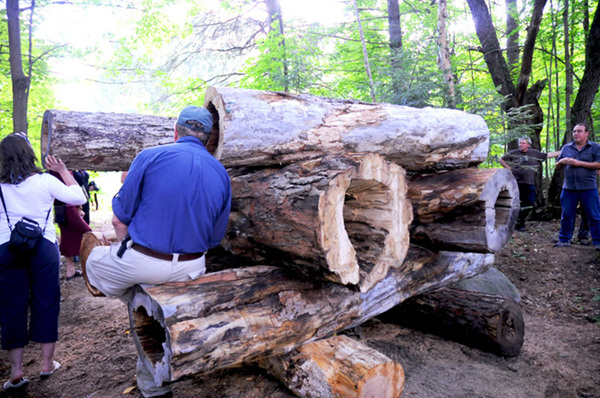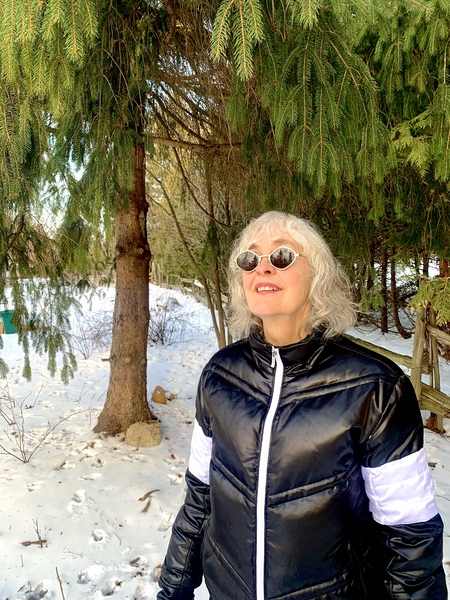Welcome!
Created in 2021, Music, Noise, and Soundscape: Gayle Young and Ryan Bruce in Conversation is a project of the Research Centre in Interdisciplinary Arts and Creative Culture homed in the Centre for Studies in Arts and Culture (STAC) at the Marilyn I. Walker School of Fine and Performing Arts, Brock University. This exhibit includes an article below, and links in the above toolbar for "Performances and Demonstrations" and an outreach activity in "Your Turn!"
Gayle Young is a composer and musician based in the Niagara region who creates her own instruments and performs music for them, often employing unusual tunings. She has also performed and recorded works by John Cage and Yoko Ono. Gayle composes works for voice and chamber instruments and creates electronic sound for film and visual art installation. Many of her compositions include environmental sounds recorded through tuned resonators that she invented to integrate harmony and soundscape.
Gayle wrote The Sackbut Blues, the biography of pioneering electronic instrument inventor Hugh Le Caine (1914-1977), who invented several instruments for electronic music, including the Sackbut, an innovative touch-sensitive keyboard instrument firstrecorded in 1946. As editor of Musicworks Magazine for over two decades, she presented an inclusive gaze on the world of experimental music.
Ryan Bruce is an ethnomusicologist, jazz historian and saxophonist. His research concentrates on the transition of jazz styles from the 1950s–1960s (bop and the jazz avant-garde) with investigations in jazz historiography, improvisation, musical analysis, and interdisciplinary comparisons to other avant-garde art forms. His work includes special focus on collaborating with performers to create digital resources for teaching jazz history, improvisation, and world music traditions.
Ryan holds a PhD in Music from York University and has published articles on jazz criticism, musical analysis, and specific musicians for the current Grove Dictionary of American Music. He is also an active teacher and performer of jazz and free improvisation on saxophone.
Curator: Catherine Parayre
Copyrights: Gayle Young and Ryan Bruce.
Photo credit: Reinhard Reitzenstein
Note: The Brock University Library is not positioned to grant licenses to or “approve” requests from third parties to make use of content in the collection. It is the user’s responsibility to obtain any necessary permission from the copyright holders.
Music, Noise, and Soundscape:
Gayle Young and Ryan Bruce in Conversation
Citation: Gayle Young and Ryan Bruce. Music, Sound, and Soundscape: Gayle Young and Ryan Bruce. Curator Catherine Parayre. Digital Repository, Brock University Library, 2021. https://exhibits.library.brocku.ca/s/music-noise-and-soundscape-gayle-young-and-ryan-bruce-in-conversation/page/welcome
Musicians Ryan Bruce and Gayle Young met online over the spring of 2021 to discuss the intersection of noise and music in preparation for The Culture of Noise, a course led by Ryan in the Centre for Studies in Arts and Culture at Brock University. Edited excerpts from their interviews form the basis of this article.
Ryan asked Gayle about the concepts and ideas that guide her work as a composer, sound artist, and instrument builder. Her instruments facilitate music using new tuning systems, and she constructed tuned resonators to record Tonal Soundscapes that integrate music with environmental sound. Her sound installations often include found objects such as resonant stones and sticks.
Our conversation covered the design of two of her instruments, the tuning systems she works with, soundscapes and sound installations, and ideas about noise in music. As our discussions were conducted during the COVID-19 pandemic, we concluded by playing improvised music together online.
Ryan: Your flexible approach to different methods of working with sound is an important element of your work. You have used a wide variety of materials and created instruments to make new kinds of sounds and noises. This is significantly different from my training on traditional instruments like the piano and saxophone. How did you get started with this inventive approach?
Gayle: After a few years at York University in Toronto studying cultural change in Europe during the scientific revolution, I changed direction and applied to study composition. Before that I had played music from classical to folk as a hobby. When I auditioned, I explained that I wanted to develop music that emphasized continuity between contrasting sounds. I had previously written about the increased cultural emphasis on difference and categorization that reflected the scientific practice of defining and labelling. That habitual way of understanding the world around us affects our awareness and leads to a tendency to separate things rather than connect them. I felt that the reliance on dramatic contrast in European classical music reflected that outlook, and I wanted to express something in music that opened up those boundaries.
Studying the histories of science and music led me to think of sound in acoustical terms, and perceiving sound in terms of physics became as important to me as expressive and descriptive ways of listening. All sound is vibration carried by airwaves; that’s what our ears perceive. I was listening and playing between categories, exploring the cracks between traditional elements in music. That soon led me to expand the languages that music is based on, such as tuning systems.
Ryan: What kinds of tuning systems?
Gayle: Familiar piano tuning is a good place to begin, with its twelve-note scale based on the seven white notes and five black notes. The notes are equally spaced, so we call that an equal-tempered tuning. Because of the equal spacing, music can be easily transposed, played higher or lower. Transposing down is useful if a note is too high for a singer for example. It allows the same melody to be played in any one of twelve different keys. It was an important achievement that opened the door to transposing sections of music into a sequence of different keys within the same piece. Each note has a different number of vibrations per second, and faster vibrations are described as higher notes. The exact number of vibrations per second for each pitch is determined by dividing the octave exactly in twelve using logarithmic math.
Ryan: There are microtones in the Columbine, the first instrument that you built. For example, there are five intervals between the notes A and B. And there are twenty-three notes in an octave so the spaces between the pitches are smaller than the white and black keys on the piano. How did you organize the notes?
Gayle: It’s based on simple arithmetic, on fractions, much simpler than logarithmic tuning. This method of tuning is called just intonation or proportional tuning, and it has been developed in different ways in different cultures all over the world for thousands of years. In both systems, a note an octave higher has twice as many vibrations per second. That’s what happens if you activate only half a string length, it vibrates twice as fast. You get different notes if you activate a quarter of the string length, or a fifth of it, or two thirds of it. There are drawings of Pythagoras in ancient Greece measuring string lengths to set tunings.
Each pitch has a specific number of vibrations per second and that number is its frequency. The E above middle C vibrates 330 times in one second, and the E an octave higher vibrates twice that fast at 660 vibrations per second. When you stop the string at one third of its length, it produces three times the frequency. There’s a new frequency for every new fraction. If you multiply 330 times 3, then you have 990, then if you divide that by 2, the frequency is 495 vibrations a second. That’s the fifth between the higher and lower notes of the octave. If you blow over a beer bottle you can get a melody that's created by the same thing happening inside the bottle, vibrating the air in a third of the length of the bottle, or the whole bottle, or half of it, maybe a quarter of it.
The tuning gets more complicated when you add and subtract the fractions from one another; that’s how melodies and harmonies are made. Just tuning offers a vast range of possible pitches. I developed the tuning of the Columbine by deciding on a thirteen-note scale and then transposing the entire scale up by a just-tuned major third which is a frequency ratio of 5/4, and also down by the same amount. A lot of the notes are shared between the scales, so I only added five new pitches with each of the transpositions. The result is twenty-three notes in each octave, almost twice as many as on a piano. I named the instrument Columbine after a five-pointed flower, because I didn't go above the number five in the fractions I used to determine the tuning.
Gayle demonstrates the tuning of the Columbine and a short étude to highlight the microtones. A separate video of the étude also demonstrates the piece with visuals of her notation on the Columbine. Please see the videos for Columbine Demonstration and Columbine Étude on the Performances and Demonstrations page.
Ryan: Within that tuning, some intervals are perfect fifths and some of them are close but not quite perfect. That’s a rather fine distinction.
Gayle: The smallest interval on the Columbine is 81/80, and there are three of these between the A and B. That interval sometimes caused problems before twelve-tone equal tuning because most choral music was written in just intonation where not all the fifths are equal.
Ryan: When you're listening to those two very small intervals together, you really have to listen carefully to hear the difference. When you played the piece [from the Columbine Demonstration video], it was like putting a highlighter on the difference between those notes.
Gayle: I play this piece slowly so that the two pitches sustain for a while and the difference between them is easier to hear. There are two places on the instrument with three 81/80 microtones side by side, and I juxtaposed them all with perfect fifths.
Ryan: That's cool—it's pretty complicated in terms of arithmetic, but my perception of it is that we have something that's kind of like a “wawa” effect, especially at the end [of the demonstration video] when you played the two notes at the same time.
Gayle: If you have two notes that are not quite in unison there's something called beating where the loudness goes up and down, and that was happening between those notes.
Ryan: It’s interference beating. They call it that because the two notes are interfering with one another. Some musical traditions have pieces that incorporate interference tones. They often build instruments that are slightly out of tune, but not in an unsettling way. The sounds are not mapped onto Western tuning systems, so initially we might perceive a discrepancy or disturbance in the sound because it's creating some sort of noise that we're not used to. In the end, what comes out is a very rich tone.
Gayle: Speaking of noise, the bow is a noisemaker and any bowed instrument creates sounds that include a lot of noise.
Gayle then plays the Columbine with a bow to produce a combination of noise from the attack of the bow, and sustained pitch with the instrument’s microtones. Please see the video for Columbine Played With a Bow on the Performances and Demonstrations page.
Ryan: Could you describe how the Columbine is constructed?
Gayle: I made it out of steel electrical conduit tubing that’s three-quarters of an inch wide. I went to a scrap yard in downtown Toronto to look at different possibilities. The men who worked there let me try different materials and one of them suggested brass bells from grandfather clocks. They were two or three inches wide, so the instrument would have been huge, and I decided on something smaller.
You hold the tube at a quarter of its length and hit it to hear what it sounds like. If you hold it anywhere else besides a quarter of the length, it just makes a thumping noise. It's the same acoustics as the marimba or vibraphone. All the tubes are suspended at the quarter-length which is called the node. That way, when you attach the tubes to the frame, they will still vibrate.
I tuned all the pitches for the prototype with a monochord designed and built by Bill Colvig and Lou Harrison. After my first concert featuring music for this tuning system, I decided to build a second version of the instrument with more notes at the high end. This time I borrowed a frequency counter and a sine tone generator from the University of Toronto electronic music studio to see the exact frequencies. Most of the lengths of tubing I had tuned with the monochord were exactly in tune and I was able to reuse them.
Ryan: You’ve also constructed some outdoor sound installations using tuned resonators to create Tonal Soundscapes. Can you tell me about those?
Gayle: One of my first sound installations arose in a visual art context in the early 90s when I was asked to collaborate with Reinhard Reitzenstein for a residency in the Chicoutimi area of Québec. We were invited to develop a new piece related to communities in the area. That was the first time we created an installation of tuned resonators. They are cylinders, about four inches across, ranging from about six feet to twenty feet in length. We created groups of five or six using a just-tuned melodic scale, and installed them in outdoor sites, including a viewing platform overlooking a distant waterfall and a pedestrian bridge over a river. People could put their ears against the opening of a tube, and they would hear the natural sounds combined with the pitch of the resonator. They could create their own melodies by moving from one resonator to the next. The experience of melody integrated with the background sounds of, say, the nearby waterfall, was a mixture of music and soundscape.
A few years later I recorded soundscapes through similar resonators and created compositions using those recordings. For Ride the Rails I used long resonators that were fifteen to twenty feet long, so they produced low-register sounds. I recorded trains passing through the countryside. Some of the recordings have prominent overtones, and I tuned my stringed instrument, the Amaranth, to match the pitches in the recordings. Then I edited the recordings and played a duet with the train sounds. The trains and the strings are both pretty noisy, so there’s a mix of noise and tone.
Gayle Young’s recording of the resonator part for Ride the Rails is a key element in the outreach activity found on the Your Turn! page.
She also demonstrates her instrument—the Amaranth—with its strings tuned to the same pitches as the resonators in the recording. See the Amaranth Demonstration on the Performances and Demonstrations page.
Ryan: I wonder if we can talk about overtones because I know they are important for this instrument, and some of your compositions. The bass notes on the Amaranth are tuned to low tones of the resonators, and the rest of the Amaranth strings are tuned to notes of the overtone series above those low notes. You do something similar with the tubes, but it's not based on overtones. Is it undertones?
Gayle: These recordings almost always include sounds of natural overtones within each resonator, but my system of tuning for those resonators creates an artificial undertone series. I begin with the length of, say, an A-440, about thirty inches. Then I double it to get an octave lower, then I add another length of thirty inches and get a fifth below the A-440. For Ride the Rails I began with shorter lengths and added more sections, always using multiples of the shortest resonator. Each time I would get an undertone that mirrors the overtone series, going lower in pitch rather than higher. The undertone series does not exist in nature—it's an arithmetical construct—so I call this an artificial undertone series. By the eleventh undertone, the tuning departs from familiar intervals and introduces a pitch pretty close to a quartertone, half of the difference between two notes on a piano. This is where things start to get microtonal. It's an eleventh undertone and it's the mirror image of the eleventh overtone.
Ryan: To go over your process for Ride the Rails, you started with a number of cylinders that act as resonators, each with a length that is a multiple of the shortest one. This creates an artificial undertone series in relation to the shortest resonator. You then took the ninth, tenth, and eleventh ones of the series and recorded the sound at the far end of the resonator when trains would pass by. As the noises pass through, they create a sound that combines the train noises and the low pitches that result from the resonators. The two shorter ones—the ninth and tenth of the series—produce pitches that are spaced similar to equal temperament, but the eleventh resonator has a pitch about a quartertone away, so the tuning of the resonators is microtonal.
After you recorded the sounds from the tubes, you used the bass tones to tune the Amaranth: the three bass strings are tuned to the same pitches as the tubes, then the remaining higher strings are tuned to the overtones of the three low strings. I expect the result to be quite microtonal because you have the overtones of the equal-spaced notes—related to the first two bass strings and the two shorter resonators—and multiple strings that are the same pitches as the overtones of the lowest note, which are derived from the lowest string and the largest tube.
I like this idea because it combines a system of artificial undertones (from the resonators) with their overtones tuned on your instrument, and these sounds are combined when you play the Amaranth with the recordings. The basis of this idea, though, is when any sound or noise passes through a resonator, it creates a tone if we listen to the other end. You have built a portable instrument that has tubes of different lengths, right?
Gayle: Yes, I have two sets, one in Grimsby and another in St. John’s. To record for the piece Fissure in 2002 I made a large backpack full of pre-cut lengths, with some three-inch wide ones inside the four-inch ones, and I took taxis to different places near the St. John's area in Newfoundland to record water sounds. I began with a little creek, then a small river with a waterfall, then ocean waves rolling into a huge fissure by the ocean. Rocks were rolling around as waves washed in, and birds were calling, so it was an interesting sound. [The recording of Fissure on the Performances and Demonstrations page demonstrates this part of the piece.]
At a stream in a hiking area near St. John's I connected all the sections in the backpack and the resonator was over twenty feet long, lying on the ground. People came along and asked what I was doing, and I said, “here, listen through this end.” Everyone who tried it was excited to hear how the sounds from the little creek combined with that low pitch. Our motivation for the first resonator pieces in Québec was to invite people to listen to this combination of noise and recognizable pitch. Something similar happens when I am recording outdoors. People often notice the resonators when I record on a beach, and they respond with great interest when I invite them to listen. I have a larger set of resonators in Grimsby, with some longer sections because I can usually travel to recording sites by car, as I did with the trains. I’ve been a guest artist at Brock a few times and brought some portable resonators for soundwalks with students. They were intrigued and we spent some time listening through the resonators to try out sounds in various parts of the campus.
A recording from Gayle Young’s Fissure combines sounds from her field recordings with performance on the Amaranth and is available on the Performances and Desmonstrations page.
Ryan: You also create sound using natural objects and toys.
Gayle: I take an inclusive and playful approach, and I guess I’ve stayed with that, especially when I play stones or make sound installations with natural objects. I have tried out stones that I found on beaches and sticks chewed by beavers. I once noticed a pile of beaver sticks from a canoe, nice pieces of hardwood drying out on top of abandoned beaver lodges, so I got out to investigate. A lot of them resonated like marimba bars and I kept those, and then visited several more abandoned beaver lodges. I drilled holes at the nodes, suspended the pieces of wood, and created an outdoor installation called Castorimba. It's the word marimba combined with the Latin scientific name for beaver, Castor.
Ryan: It seems like there is a strong visual component in a lot of these works. How much were you thinking about the visuals of Castorimba when you were putting it together?
Gayle: For me the sound and visuals are integrated by the strong tactile presence of the materials. My primary goal was to invite people to play with sound in a kind of mistake-free environment. Often there's a “right way” and a lots of “wrong ways” to play music, especially in classical music, and people feel intimidated. With the installations, there's no wrong way to play. The materials are not fragile, and people are invited to explore the unexpected collection of beaver-chewed sticks suspended from trees. The piece also has an element of humour that lightens things up a bit.
When I play stones, the acoustic process is exactly the same as with the beaver sticks. I hold a stone at around a quarter of its length and test it by tapping it to see if it resonates. Flat shale stones rounded by waves along shorelines often resonate nicely. With larger stones I can roll things on them like a golf ball or a metal bell, or the end of a hex bolt. The sounds of stones usually include a lot of noise, but some have a recognizable pitch. I’ve collected a briefcase full of stones of different sizes, and I can lay them on top of the Amaranth to play the stones and the strings simultaneously. I rock the stones back and forth on the strings after arranging them in ways that connect with the string pitches, but again many elements of noise are part of the sound. I play duet performances with composer James Harley who does live electronic processing of the sound and circulates the sounds spatially through eight speakers. We’re producing an album of our duo.
Ryan: I like that because the stones are very much in tune with nature. There’s a connection between your soundscapes and your improvised performances. I think this is an important part of your work—like the beaver sticks, or environmental sounds filtered to create tones with resonators. You’re thinking about environmental sounds, and then bringing that into performance. Exploring the acoustic properties of rocks is exciting because we don't typically think about those kinds of things producing sound.
The conversation moves towards a planned performance of us improvising online with some of the concepts and ideas previously discussed. We briefly talk about the kind of “free” improvisation we would play as an introduction to the music:
Ryan: There is another aspect of your music that is related to improvisation, which I think of as composition in the moment. There are lots of ways of improvising, but we will be communicating with one another through sound, picking up on what each other is doing, making decisions about whether we play something similar or a bit different, and exploring ideas of sound and noise. I find that playing your instruments with different objects, mallets, or the bow gives us a wide range of possibility. When we improvise we're exploring some of those things together. A lot of improvisers do that, by thinking about their instrument as a noisemaker of some type, and then they explore different sounds and noises together.
Gayle: I enjoy improvisation because it gives us an opportunity to respond to one another. It's very social. There's a back and forth between something you play that has an element of what someone else played. Similar to the idea of noise, it can include sounds that are familiar or unfamiliar. Listeners sometimes describe unfamiliar sound as noise, and that’s often a negative judgment. If you hear a piece of music you don't like, you say it's just noise. And if you don’t hear any pattern in it, then it does resemble noise.
Ryan: [Laughs] Yeah. We’re thinking about noise as something sonic, like your perspective of having a discrete noise that relates to pitch. Earlier, you described a continuum between noise and pitch, which would be interesting to think about when we improvise and respond to each other.
Two short recordings by Gayle and Ryan explore the continuum between pitch and noise with Gayle at her two instruments: the Amaranth and the Columbine. The videos of Improvisation I and Improvisation II are available on the Performances and Demonstrations page.
Afterwords: Sound is Social
After our short improvisations we reflected on the sonic and social contexts of the music. The conversation included our thoughts about communication, sound production, musical technique, and the constraints and opportunities of improvising via video teleconferencing. We concluded by discussing Gayle’s work with composer Pauline Oliveros, who held a positive perspective on internet-based improvisation.
The music we played is called free improvisation. It was not planned in advance; there was not any notation, nor specified beginnings, endings, dynamic levels, scales, rhythms, harmonies, or the like. Our playing was led by the premise of exchanging sounds within the continuum between pitch and noise. Our individual concepts of ‘pitch’ and ‘noise’ might differ, and our improvisations were a meeting ground to explore interactions among those sounds.
Our playing and discussion routinely pointed to a focus on listening and responding to each other. We agreed that attentive listening characterized us both as sympathetic respondents while performing. We had limited experience playing together, and although the concepts and practices of improvising are familiar to both of us, our individual choices, responses, and techniques were unfamiliar to the other player.
We wanted to communicate musically within the context of a particular noise introduced by one of us, and sometimes a specific effect was amplified by the other player. One option is to identify and play specific pitched noises, align with each other, and then perhaps modify the sound or move away from it. This is a way of exploring and communicating within a common ground that foregrounds listening, free of the requirement to adhere to definitions or decisions made before playing.
For example, one can seldom reproduce the exact pitches or overtones played by other musicians. However, close approximations can add to the musical exchange, which is something Gayle describes as a “game of proximity.” It is a way of interpreting a sound and mirroring it without exact imitation. To accomplish this, each of us drew from traditional performance practice (notably pitch and articulation) and numerous extended techniques for producing less conventional sounds.
Examples in Improvisation 1 include exploring the harmonic series on the strings of the Amaranth and the air pressure of the saxophone; this changes to clicking noises through different styles. Sudden short sounds were followed by more continuous sounds of breathing (saxophone) and longitudinal bowing (running the bow parallel rather than perpendicular to the strings of the Amaranth). Improvisation 2 included more substantial pitch content to augment the microtonal design of the Columbine.
We were quick to acknowledge the conditions of improvising online that mediate patterns of typical musical exchange, unlike playing in a ‘live’ concert. Our hearing of each other was misrepresented by the separation of space and time. Streamed audio reproduces only what is captured by our microphones, or as Gayle remarked: “What I'm hearing isn't what's happening in your room, and what you're hearing isn't what's happening in my room—the sound is different when passed through the headphones.” As such, a number of details are lost, and our improvisations rely on broad musical features rather than smaller sonic gestures.
The obvious latency of sound from one computer to another makes unison rhythms impossible. This is an obstacle that other musicians have negotiated in online music making. Playing with a beat is not an option with current technology. From the outset, however, we did not intend to have temporal synchrony such as a pulse, beat, or otherwise entrained rhythm. In this regard, the difference between an in-person performance and the online experience brought more focus to the archetype of immediacy in improvised music. Where split-second reaction could be made but not immediately communicated, the artistic practice of attentive listening and response included a cyclical “now was then” envelop of time. Delayed response (slight and substantial) is a regular practice in improvising and was simply adopted as a staple feature of our playing—it also likely explains the music’s slower transitions and moments of stasis. MacDonald and Birrell report similar experiences where internet latency did not hinder interactions: “Rather, it was incorporated as an emergent feature of the improvisation” (2021, 2).
Playing online was a show of possibility within these constraints. Exploring sound allowed us to seize opportunities available in improvised music rather than compensating for something that was lost, such as synchronized parts. These affordances expose an inherent value of improvised music: when timing becomes the major concern for modes of music-making accustomed to a beat, “free” playing carries on with few complications. The positive outlook echoes Nathan Moore’s hope for a new improvisatory practice “which incorporates and transcends the current limitations of time delays, poor sound quality, broken connections, and so forth” (2021, 1). In other words, improvisation is resilient when technology can deter other sorts of real-time music making.
Improvising online was not new for Gayle. She began working with others over Skype in 2007 as part of Pauline Oliveros’ Deep Listening Convergence project. Oliveros, a trailblazer in contemporary music, developed the Deep Listening Certificate program, and frequently made technology an integral part of her activities[1] For the Convergence project, musicians trained in Deep Listening were paired from around the world early in the year. They rehearsed online, playing regularly from their homes over Skype until everyone met in person in the Hudson Valley of New York State in June. Gayle describes meeting with Swiss vocalist Katharina von Rütte from Switzerland every week for about four months:
We got to know each other musically through Skype, which had a couple of idiosyncrasies. One of them was that all the sound was at the same volume. If she made a really quiet sound and a really loud sound it came through at the same volume for me. But it meant that we heard the quiet sounds that each of us was making, so we got to know each other well.
When they met after the online rehearsals, they performed live at least three times during a week of concerts, discussions, and workshops. Gayle remembers playing on Skype as a positive experience and an excellent way to develop a musical relationship over a long distance. Over months of shared music and conversation, Gayle and Katharina came to know one another both musically and socially. No sound was left unheard. When Internet latency challenged rhythmic unisons and responses, they adapted by favouring sustained sounds, something that comes easily to singers and performing on Gayle’s instruments. In today’s context it is remarkable to reflect on Oliveros’ intentions to connect international musicians, to minimize the restrictions of geographic and cultural isolation, and facilitate musical communication between performers living in diverse countries across different continents.
With more musicians playing online since the first COVID-19 lockdown in March 2020, Gayle has been meeting with others regularly. She has noticed that improvisation is connecting people across geographical distances (even Gayle and Ryan live in separate communities of Grimsby and Toronto), and across different cultures. At first her primary interest in online performance was musical, but as the isolation continued, she experienced a high degree of social satisfaction during online events and found that they provide a much-appreciated sense of social connection.
Works Cited
Bernstein, David W., ed. The San Francisco Tape Music Centre: 1960s Counterculture and the Avant-Garde. Berkeley: University of California Press, 2008.
MacDonald, Raymond, and Ross Birrell. “Flattening the Curve: Glasgow Improvisers Use of Virtual Improvising to Maintain Community During the COVID-19 Pandemic.” Critical Studies in Improvisation/Études critiques en improvisation 14, nos. 2–3 (2021): 1–7, https://www.criticalimprov.com/index.php/csieci/article/view/6384/6211.
Moore, Nathan. “Slowing Down.” Critical Studies in Improvisation/Études critiques en improvisation 14, nos. 2–3 (2021): 1–2, https://www.criticalimprov.com/index.php/csieci/article/view/6419/6281.
Oliveros, Pauline. Deep Listening: A Composer’s Sound Practice. New York: iUniverse, 2005.
Note
[1] For example, see Bernstein for Oliveros’ pioneering work with the San Francisco Tape Music Centre in the 1960s. See Oliveros for her guide to the practice of Deep Listening.
